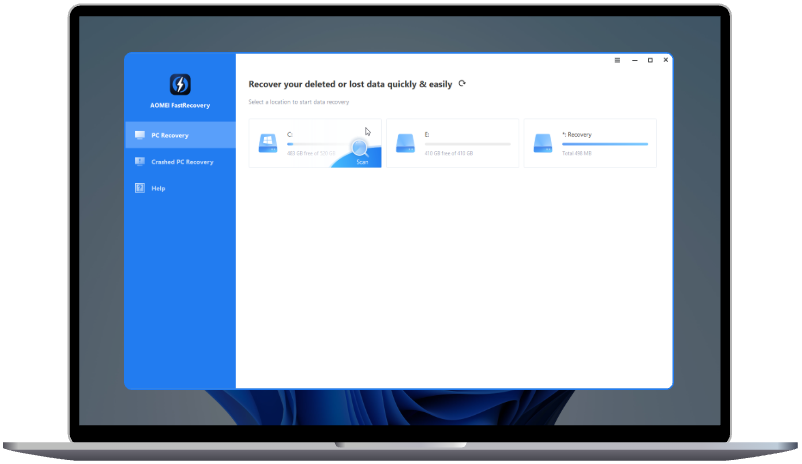exFAT Allocation Unit Size: Which is the Best and How to Set it?
What is exFAT allocation unite size? Which size is the best for exFAT? In this passage, you can get all you want to know with a powerful tool and an easy method for easily changing the cluster size.
What is the allocation unit size?
When you use an SD card, USB flash drive, or storage devices, you may be confused in choosing the suitable allocation unit size for exFAT when creating or formatting the disk.
What is the allocation unit size? The allocation unit size, also known as the cluster size and block size, refers to the smallest logical amount of disk space that be used for storing or managing disk files. Most hard drives are split up into many clusters (allocation units ) for storing data. When the partition is created or formatted, this size is picked and tells the computer how much space a file can take up on the hard drive.
🔷Large Allocation Unit Size: Improves performance with larger files, reducing the overhead of managing many clusters.
That is to say, each cluster size can only hold a single file. If your file needs 4097 bytes, the allocation unit size should be 4096 bytes. On the contrary, if the cluster size is 512 bytes, 9 clusters are needed for storage, and the actual space occupied is 4608 bytes.
As you might think, the smaller clusters are, the more space is saved. However, in fact, saving small files on a file system with a large allocation unit size wastes space on the disk, and saving big files on a file system with a small cluster size slows down the system. Besides, smaller clusters also need more time to search for files when reading them. Because of this, choosing the right allocation unit size is necessary for your system to work well.
What is the best allocation unit size for exFAT when formatting an SD card or USB? That's what we'll talk about next.
What is the best exFAT allocation unit size?
Microsoft made the exFAT file system, and this is what they say is the standard exFAT allocation unit size:
| Allocation Unit Size | Best For | Advantages |
|---|---|---|
| 512 bytes - 4 KB | Small files and system drives | Efficient space usage, minimal waste |
| 8 KB - 16 KB | Mixed file sizes | Balanced performance and efficiency |
| 32 KB - 64 KB | Large files (videos, images, backups) | Faster read/write speeds, lower overhead |
Although exFAT theoretically supports up to 512 TB (or 128 PB), the practical limit is usually 256 TB, as shown in the table. A 64GB exFAT drive typically uses a 128KB allocation unit size. If you're unsure how cluster size affects performance, the default exFAT setting is a reliable choice, as it automatically selects the best size based on partition size.
To ensure compatibility between Mac and PC, format the exFAT external drive on a Mac or set the allocation unit size between 128K and 1024K. For those handling a mix of file sizes, an allocation unit size between 8 KB and 16 KB offers the best balance.
How to change the allocation size for exFAT easily?
AOMEI Partition Assistant is a reliable, multifunctional disk manager for Windows 11/10/8/7. It allows you to format any disk, like SSD, HDD, USB drives or SD cards to exFAT and easily adjust the allocation unit size between 0.5KB and 32MB. You can also convert exFAT to NTFS, FAT32, and Ext2/3/4 or format damaged and write-protected partitions. Download it to change the allocation size for exFAT easily without our guide.
The Best Windows Disk Partition Manager and PC Optimizer
Step 1. Connect USB drive to your PC. Install and run AOMEI Partition Assistant and you’ll see your drive at the main interface.
Step 2. Then right-click the partition on your hard drive and select Format Partition.
Step 3. In the pop-up small page, choose exFAT from the drop-down menu next to File System.
Step 4. In this stpe, you can change or set the allocation unit size for exFAT by selecting the Cluster Size.
Step 5. Preview the virtual result. Click Apply and later Proceed after your confirmation.
1. If your USB drive shows up as Unallocated, you can right-click the unallocated space and select "Create Partition" to create a partition with exFAT formatting.
2. If you have not made backup before changing the allocation unit size for exFAT by formatting and suffer data loss, you can follow the guide to recover data from the formatted hard drive.
A professional way to change allocation unit size for exFAT
Windows Command Prompt is a useful tool for managing disks, partitions, and other operations, including changing the exFAT allocation unit size. However, if you're not familiar with command lines, it may lead to data loss or system issues. To ensure safety, it's best to back up your data before proceeding.
Here are the quick steps to change the exFAT allocation unit size in CMD:
Step 1. Go to the search bar of the Windows system to type cmd and then select "Run as administrator." Type diskpart, and press "Enter."
Step 2. Type the following commands one by one and press "Enter."
- list disk
- select disk * (* stand for target disk or partition number)
- list partition
- select partition * (* stands for the partition number)
- format fs= exFAT unit=32k (the 32k allocation unit size can be changed to other also)
When formatting a drive to exFAT via CMD, the allocation unit size typically ranges from 4 KB to 32 KB (or up to 64 KB for larger volumes), with larger sizes improving performance for big files but wasting space on small files. If you want to easily change allocation unit size for exFAT, it is better to choose a hany tool.
Tip: How to improve performance except change allocation unit size
As mentioned earlier, larger clusters (e.g., 128KB) improve read/write speeds and reduce fragmentation for large files, while smaller clusters (e.g., 4KB) save space but may increase fragmentation and slow performance. If your goal in changing the exFAT allocation unit size is performance optimization rather than file system compatibility, AOMEI Partition Assistant offers more practical solutions.
The Best Windows Disk Partition Manager and PC Optimizer
1. Extend Partitions – Expand system or data partitions to prevent slowdowns caused by insufficient disk space.
2. Move Applications & Data – Transfer apps and files to another drive, freeing up space and maintaining system performance.
3. Migrate OS to SSD – Migrate the OS to SSD, resulting in faster boot times and improved system responsiveness.
4. Defragment HDD – Run disk defragmentation in traditional hard drives, ensuring smoother and more efficient performance.
Final words
Now, you know what is the exFAT allocation unit size and how to set it with AOMEI Partition Assistant. If you still worry about whether the allocation unit size you set will affect your disk performance or cause space waste, you can directly run the downloaded software for troubleshooting. For example, you can move installed programs to another drive, allocate free space from partitions have sufficient space, or use it to monitor disk health. If you are a Windows Server user, you can choose the AOMEI Partition Assistant Server edition.
FAQs about allocation unit size for exFAT
1. What is the size limit for exFAT drive?
exFAT has a maximum capacity limit of 128 PiB (approximately 134.2 billion TB), which is considered virtually unlimited for practical purposes.
2. What is the allocation unit size for exFAT 128GB SD card?
32KB is the recommended and default allocation unit size for an exFAT-formatted 128GB SD card, offering a balance between performance and space efficiency.
3. Is it best to reformat the hard drive to exFAT using 512kb chunk, or smaller or bigger chunks?
The choice depends on your usage. For a mix of file sizes, the default (typically 32KB) is recommended. Smaller sizes improve space efficiency for tiny files, while larger sizes enhance performance for large files.
4.Why is exFAT's default allocation size in Windows so high?
Larger allocation unit sizes improve read/write performance, especially for larger files. This default setting in Windows aims to balance performance and compatibility with various systems.
5. How can I check the cluster size (allocation unit size) of an exFat partition on Windows?
You can use the Command Prompt with administrator privileges: fsutil fsinfo ntfsinfo :. The "Bytes Per Cluster" value represents the allocation unit size in bytes.

